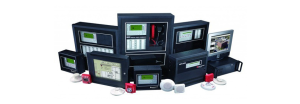Fire hazard
Classification of places according to fire risk
We will examine the classification of fire risk in places so that we can calculate the amount of water with pressure and the appropriate duration for the sprinkler system according to each floor (class). Obviously, controlling and extinguishing fire in an office room is easier than in an oil and gasoline warehouse.
As with most important events in the sprinkler industry, this time insurance companies took the first step in classifying buildings by dividing them based on material value and vulnerability to fire. By the end of the 19th century, 584 different classes were designated by insurance companies. In 1932, this number decreased to 26 floors, but in 1946, it increased again to 100 floors, which were divided into 6 groups based on the type of building structure.
Today, NFPA 13 divides buildings into five different classes based on the flammability of materials present, the amount of flammable materials, the height of goods stored, and the rate of heat released, which differs from other building codes and even other NFPA codes.
This division consists of:
- Light Hazard:A building or a part of a building where the quantity, flammability and heat release rate of the materials in it are low.
Office buildings, residential buildings and hospitals are included in this group. Extinguishing this class is easier than other classes and requires less water.
- Ordinary Hazard-Group I (Ordinary Hazard-Group I):A building or a part of a building where the flammability of the materials in it is low, the amount and rate of released heat of the materials in it is average, and the height of the stored materials is less than 8 ft (2.4 m).
Extinguishing this class, which is also displayed as OH 1, is more difficult than the low-risk environment and includes places such as restaurants and parking lots.
- Ordinary Hazard – Group II environment:A building or a part of a building where the amount and flammability of the materials in it is above average, the rate of heat released by the materials in it is average and the height of the stored materials is less than 8 ft (2.4 m).
Rubber factories and post offices are in this class (OH2).
- Extra Hazard – Group I:A building or a part of a building where the amount and flammability of existing materials is very high, the rate of heat released in it is high, the speed of fire spread in this class is high, but the amount of flammable liquids is very low.
Foundries and teahouses that use compounds with a flash point of less than 100 degrees Fahrenheit are placed in this class (EH 1).
- Extra Hazard – Group I:A building or a part of a building where the amount of flammable liquids is significant.
Extinguishing this class (EH2) has the most difficult conditions compared to other classes, but it should be noted that if the amount of flammable liquids exceeds the permissible limit, then in the design of the sprinkler system, the conditions listed in NFPA 30 (Flammable and Combustible Liquids Code) should be used. Be considered. The place where flammable liquids are sprayed is classified as EH2.
Fire hazard
This question may arise, if there is more than one risk class in a building, which class should the system be designed according to?
In response, it should be said that if the places can be physically separated from each other, then for each class we consider the rules related to the design of that class independently, but if they cannot be separated from each other physically, the design It is done based on the higher risk class.
It should be remembered that the maximum area covered by a sprinkler system on each floor is determined according to the risk class of the environment and its value is equal to:
- Low risk environment: 52,000 square feet (4831 square meters)
- Typical hazard area: 52,000 square feet (4831 square meters)
- Hazardous environment: 40,000 square feet (3716 square meters)
- Warehouses with goods greater than 12 feet in height or warehouses covered by other NFPA codes: 40,000 square feet (3,716 square meters)
More examples regarding the classification of places based on fire risk (taken from NFPA 13) are:
Low fire risk places include the following places or similar places:
- religious places
- Clubs and clubs
- educational institutions
- Hospital
- institutes
- Small libraries
- Museum
- Home for the Aged
- offices
- residential areas
- restaurant
- theater hall, conference, except for the stage and front
- Unused attic space
Typical fire hazard spaces of group 1 include the following locations or similar locations:
- Car parking and showroom
- Bakery
- Beverage production
- Canning production
- Dairy production
- Electronic equipment manufacturing factories
- Electronic processing unit
- Production of glass and glass products
- laundry
- Restaurant (cooking place)
Typical Group 2 fire hazard environments include the following locations or similar locations:
- Grain mill
- Factories producing chemical products
- baking sweets
- dry cleaning
- stable
- Production of leather products
- Large libraries
- Machine workshops
- Commerce
- paper production
- Wharf and loading dock
- Printing and Publishing
- repair shop
- Stage
- Textile production
- Automobile tire production
- Logging and manufacturing of wood products
Group 1 high-risk environments include the following locations or similar locations:
- Aircraft hangar (except as specified in NFPA 409)
- Casting
- Metal extrusion
- Production of multi-layer wooden boards
- Printing (using compounds whose flash point is less than 100 degrees Fahrenheit or 38 degrees Celsius)
- Recycling, compounding, drying of tires
- cutting
- Home appliances with plastic foams
Group 2 high-risk locations include the following locations or similar locations:
- Spray flammable liquids
- Factories manufacturing prefabricated houses
- Plastic production
- Detergent solvents
- painting
Source: Design and calculation book of sprinkler fire extinguishing systems
دیدگاه خود را با ما در میان بگذارید














